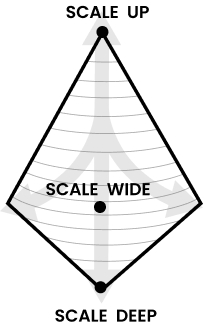LEADERSHIP MINDSET
As a system designer, I see leadership as belonging to interactive systems of people, and striving to build resonance relationships through the quality of interactions my influence can activate. My role is to remain in tune and on the same wavelengths as the people I manage and to act as a bridge builder to help them achieve their goals.
I do not have a fixed leadership style because of the nuances of human interactions and social complexities. However, I strive to continually improve a high level of self and social awareness to contextually negotiate the right tool kit to build real-time team cohesion & intimacy.
Access to Resources
I give designers access to a palette of design tools and my time and experience so they can make their own decisions ( choices in their own image). I provide Design education, industry innovations, toolsets, and methodologies, and trust my team to make their own calls and that bring the nuances and contextual uniqueness of their own space and their practice.
Therefore, much of my job is about staying up to date with industry innovations, Design theory and practice (craft) and helping designers to apply them within the contextual uniqueness of their own positionally in the work-place system.
Access to Belonging
I create teams through a human lens. I strive to create intimate and cohesive teams within which designers can feel a sense of belonging and community - making them feel valued and catalyzing their ability to innovate and grow. This begins with understand my own needs and the needs of the team through a human lens.
Human Lens:
Team members are people first then workers. They have their own challenges separate from work that needs to be accounted for. When they come to work these challenges are expected to be put in the parking lot but we forget that there is no separation. Learn to see people as people with interconnected experiences
Access to Growth
Access to belonging and resources acts as a catalyzing agent to allow individuals and the team to grow. Growth is defined by the elevating design capacities and the ability to tackle design problems.
As a design leader, I position "learn it, practice it, teach it" (LPT) as the primary growth principle. In this process, a designer is introduced methodologies or tool which they then practice within their unique role and design practice. They then have opportunities to teach on the new methodology or tool based on their experience of using it.
LEADERSHIP PHILOSOPHY
Tri-Scale Design Leadership
I created "Tri-Scale Design Leadership" as a comprehensive framework that empowers design leaders to adapt and drive meaningful and lasting change across all levels of scale within their organization and team. It combines Scale Up, Scale Deep, and Scale Wide to ensure that the leader can influence an organization's systems, culture, and a greater number of people.
These design pillars are positioned to address immediate needs but also positively influence the systemic transitions to build better products and services while improving and cultural fabrics of organizations.
Scale Up: using design to influence the leaders and policies in an organization. Scale Wide: broadening an impact to new teams and disciplines. Scale Deep: bridge building to improve teams' cohesion, capacity building & self-empowerment.
Scale Up : influencing leaders and policy within an institution.
Scaling up involves leveraging design in changing policies, practices, and procedures within organizations or institutions to increase synergy and alignment with organizational members. This may require engaging with decision-makers at the leadership level to gain their support and buy-in, reducing bureaucracies, and developing strategies to overcome resistance or barriers to change/innovations on an organizational level.
scale up
- - Understanding what is expected of design and developing a strategy for what design will mean to the organization and system.
- - Collaborating with cross-functional and non-design leaders to make design influence an organizations objectives
- - Educating non-designers on the value of design within the organization and system.
- - Building capacity and infrastructure to support scaled-up models or interventions, thereby expanding design's impact.
Defining Expectation from Design Within an Organization
Scaling up is an opportunity for Design to define what it will mean for an organization, rather than waiting for non-designers to find ways for design to contribute. As a design leader, I help organizations discover that design means the following:
- - Building skakeboards, not car frames: design is the re-iteration of minimum viable products (MVPs) towards a final product, rather than the process of building individual components that have no function until they are brought together.
- - Experiments, not debates lead to successful products: design is a collaborative rather than combative process with other designers and non-designers.
- - Success is not quantifiable by increased outputs: speed is the enemy of great design. Design teams must carve the space needed to improve outcomes.
Scale Wide: broadening an impact to new teams and disciplines.
Scaling wide allows design leaders to extend their impact horizontally by replicating and adapting successful designed models to new contexts. It seeks to drive team intimacy, cohesion, and innovations in teams through a transdisciplinary lens in the quest for cross-functional and flat team structures.
This involves facilitating knowledge exchange and peer learning, as well as building alliances and coalitions for collective impact, and requires a high level of trust across disciplines and departments. Scaling-wide is also an opportunity to learn from and address natural systems.
Scale Wide
- - Embracing systemic thinking to identify leverage points for organizational change.
- - Engaging with stakeholders to adapt models to new contexts
- - Building lateral relationality, interdependence, and connectivity to facilitate the spread of successful models
- - Fostering interdisciplinary collaboration and knowledge sharing between designers and non-design teams.
Attitudes for Cross-Functional Teams
For cross-functional teams to work well together, they must successfully adopt a range of attitudes. It is a design leaders responsibility to foster them amongst design and non-design teams:
- - Design as a team: designers and non-designers are teammates rather than adversaries in the effort to spread successful models.
- - Spreading the "founder mindset": all people in an organization or system must be determined, creative, resourceful, and resilient to find innovative solutions to the barriers preventing the proliferation of successful models.
- - Everything is my job: the design leader must be able to take on any task needed to advocate for successful models to persuade non-designers to proliferate them at their place in the system.
- - I am not the user: the design leader must be empathetic with the needs of non-design teams and the end users of products and models.
- - Respectful & confident, not delicate: design and non-design teams may come into conflict, and a design leader must not be assertive enough to help cross-functional teams understand the importance of design within an organization.
Scale Deep: Bridge builder to improve contextually responsive teams cohesion, capacity building & self-empowerment.
Scaling deep begins with operationalizing design excellence and allows a leader to become a servant leader and have a longer-lasting impact on a team. This involves cultivating empathy and compassion, challenging power dynamics, advocating for transparency, autonomy, and accountability, and fostering safe spaces for dialogue to develop new mindsets and postures. Scaling deep strategies empower leaders to facilitate more inclusive and equitable teams.
Scale Deep
- - Encouraging reflexivity and critical self-awareness within the design team
- - Fostering empathy, compassion, and understanding for users, communities, and non-designers.
- - Advocating for transparency, accountability, and ethical decision-making, and helping designers to understand the impact of their actions within a system.
- - Creating safe spaces for open, honest, and respectful dialogue within design teams, and while working with cross-functional teams.
- - Develop self-empowerment strategies and career goals for all team members.
Deep and Personal Care
Leveraging resonant relationships towards a long-lasting impact on the cultural roots of a team requires a design leader to care personally and deeply about their co-workers. This includes a knowledge of them as people, their values, their goals, and how they want to be helped to grow in the creative process.
A caring design leader must also be aware of the lives of their co-workers through an "air cover" approach that humanizes them. This involves making the effort to get to know them as people inside and outside of work, and being empathetic of their personal struggles that may impact their work. "Air cover" leadership builds trust towards a "servant leader" within a caring and compassionate environment, and avoids employee burnout and churn.
Inside of work, caring deeply means taking their career goals and expertise into account when assigning roles and projects, and finding intersections between company needs and employee goals. This process ensures that employees can have the impact they desire within systems and organizations.
Caring design leaders are also mentors to bounce ideas off of. It is my role to help designers make decisions and hold themselves accountable to their impacts, rather than to suggest a single "correct" way to design.
Trust and Accountability
Scaling deep requires team members to feel trusted, autonomous, and self-accountable within a system. The design leader must trust designers to solve problems with their own methodologies, rather than telling them how to do their jobs, and to set meaningful targets for their impact. We hire smart people to tell us what to do, and trust is an essential component in giving them the space to do that.
Team members fit their self-defined targets within mutually-beneficial projects set for them to achieve. I set projects that match the team member and have defined scope (outcomes), milestones, and a clearly defined end. This creates a culture of two-sided and trusting project management and assignment.
Team members also trust me to remain close enough and never lose sight of them within the system so that I can understand and anticipate projects, providing the tools required to remove and barrier. Part of scaling deep as a design leader is working as closely as possible to team members to help unearth new questions and problems that may not have occurred to them.
Committing to Working Together
A critical component of building a culture of empathy, compassion and accountability is the ways that design leaders and their colleagues communicate with each other. The entire team must be comfortable using direct and radical candor, sharing feedback laterally and vertically within the team that is communicated directly and avoids "ruinous empathy."
Team members receive feedback on their projects from their colleagues at least once a week, in meetings where everybody is invited to speak their mind, but nobody dominates the conversation. These sessions may have cross-functional representation to ensure the conversation and our culture is opened beyond our team.
I also challenge and praise individuals directly and clearly. This is a two-way process whereby I actively seek and give candid feedback. When challenging each other, my teams state what needs to happen, by when, and the results if progress cannot be made by the desired date. Our culture of praising is similarly specific and candid. I avoid "good job" statements, and position myself close enough to colleagues to understand what praise they would appreciate.
Candid communication cultivates empathy and compassion by recognizing our co-workers as humans with unique needs. It prevents designers from feeling the need to justify everything they are doing, while ensuring that they can hold themselves and each other to account.

















